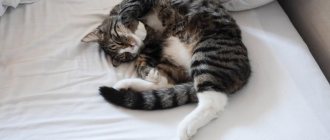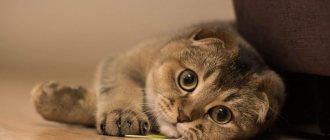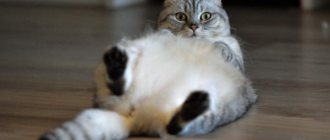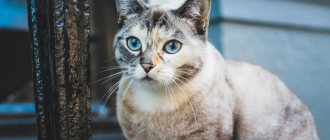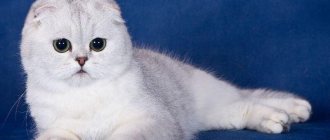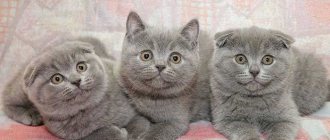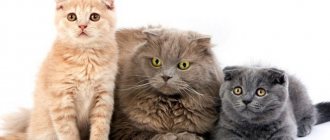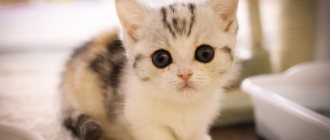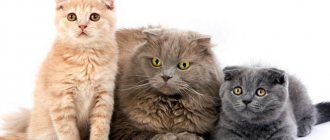What is tortoiseshell coloration in a cat?
The fur coat of a tortoiseshell cat combines a variety of shades from the black and red palette. It is covered with multiple multi-colored spots and stripes, differing in size and shape.
It is important to note that black points (colored areas) always have clear boundaries, while red points are always blurry. The eyes of such cats are usually orange or copper-gold, and the color of their nose and paw pads coincides with the predominant color of the color.
After such a description, many may have a misunderstanding about where the white color went. After all, very often it is he who decorates the “three-flowered” fur. The thing is that, from a scientific point of view, this term refers to the absence of color. White animals lack the pigment responsible for coloring their hairs.
Kinds
Felinologists distinguish two main varieties: patchwork and scaly.
Patchwork
Another name is calico. The English word "calico" means calico fabric. Calico combines clear spots of rich black, red and pure white colors and this really resembles a chintz blanket sewn from scraps.
Scaly
Another name is torti. A chaotic combination of colors is assumed here, for example, blue and cream or black and red. The spots are small, like scales, hence the name. Their boundaries are unclear, shades can flow into one another.
Genetic conditioning and inheritance
Speaking about color, it is necessary to clarify that this concept covers not only the color of the fur, but also the pattern on the fur coat. Melanin is responsible for the pigmentation of these zones, which is divided into 2 types:
- eumelanin, which gives black color due to the absorption of light rays;
- pheomelanin, which produces a red-yellow spectrum due to the reflection of light rays.
The appearance of an animal directly depends on the inherited genes. The listed pigments are contained in the X chromosomes and can give the following color options:
- black(oo);
- red (OO);
- tortoiseshell (Oo).
The remaining genes are responsible for color intensity, that is, its brightness, saturation and contrast. Based on this characteristic, colors are divided into white, agouti, tabby, solid, piebald, silver and acromelanic, that is, temperature-dependent. This diversity is explained by the need for camouflage among wild ancestors, who skillfully blended into their surroundings while hunting.
It is enough to look at solid shades to understand the possible variety. Red and black of varying intensity give the following options:
- blue or gray;
- chocolate;
- cream;
- blue-cream.
Please note that it is impossible to arrange chromosomes artificially, so the birth of a tortoiseshell kitten is a matter of chance. In a litter of turtle cats, completely ordinary babies with black or red coats are often born.
Care and maintenance
The Persian cat is an elite breed. Keeping such an animal will require a lot of attention and considerable financial expenses from the owner. You are unlikely to find any other cat that would be as dependent on a person as the Persian. In order for your pet to always be beautiful and healthy, you will have to provide him with proper care, balanced feeding and proper support from an experienced veterinarian.
As for the living space, everything is more or less clear here. Persian cats are very calm and pliable; they like to spend a lot of time either in the arms of their owner or in a cozy, comfortable place allotted to them. They will easily get used to both the conditions of a city apartment and a large country house. The main thing is that family members do not forget about the animal.
Owners of private houses do not have to worry about their cat getting lost when going out for a walk. Persian cats are exceptional homebodies, and walking outdoors is not one of their favorite activities.
These cats are not hunters at all. Due to their phlegmatic nature, they get along well with other pets, including birds and rodents.
The Persian cat really values comfort and coziness. If opportunities allow, purchase a special sleeping place for your pet - a house or a bed. Your concern will definitely be appreciated. A soft chair or sofa will be a completely acceptable alternative for the animal. In this case, you should exercise caution and attentiveness, especially with a kitten. You can inadvertently injure your baby if he sleeps in your bed or likes to lie in the chair in which you are used to reading newspapers or watching TV.
Clipped Persian cat
Persian cats are very impressionable creatures. Never force your pet out of its home. If the cat is resting, do not touch it. Wait until your beauty wants to go outside on her own; in extreme cases, lure her with her favorite treat or interest her with a toy.
If your cat's house is not equipped with a scratching post, make sure to purchase one additionally. Ask the breeder what type of accessory the kitten is familiar with and buy a similar product. To train your little Persian to sharpen his claws in one place, use catnip. If you notice your animal's desire to get a manicure, immediately take it to a certain place. Persian cats are very intelligent creatures and will quickly figure out what you want to achieve from them.
Like any cat, a representative of the breed is very clean and will definitely try to bury the products of its vital activity. Persians can dig around in the litter box for a very long time before going to the toilet. To avoid being irritated by the filler scattered around, purchase a large tray with a high side (at least 10 cm). Prefer granular filler with high absorption capacity over wood filler. Immediately buy a tray designed for an adult animal. It will be convenient for the kitten to do his business in it, and when he grows up, he won’t have to spend money on a new one. The toilet can be placed on a larger rubberized mat. This will make cleaning up after your pet much easier.
An important accessory is a special carrying bag. You will need it for a visit to the veterinarian, for a trip to an exhibition, and when moving from a city apartment to a country house. The accessory must be suitable in size for the pet so that the animal feels comfortable enough inside.
White Persian cat
Thanks to its thick, long hair, the Persian cat tolerates the cold well, but it is still worth taking some preventative measures to avoid colds. Do not place the cat house or bed near entrance doors, windows or other places where drafts are possible. And if your pet prefers to spend time lying on the windowsill, lay a soft, warm cloth for him.
Just try to take my chicken
In matters of nutrition, almost all breeders without exception recommend choosing ready-made food of the highest quality category. Precisely calculated and well-balanced daily intakes will provide your cat with everything it needs, even without adding natural products to the diet. Mixed or natural feeding is more troublesome, since sometimes there is not enough time to prepare food for the cat separately, and the human menu is not suitable for it by definition. Seasonings, sugar, and salt in excess quantities can cause serious harm to the cat's body. Be sure to introduce special vitamin supplements with a seaweed complex into your cat’s diet in the required proportions (1 tablet with calcium + 3 tablets with algae extract or vice versa - depending on color) (for any type of feeding). The availability of freely available clean water is not even discussed.
Persian cats are prone to overeating, so you need to control their diet and under no circumstances feed them from your table or from your hands.
The special pride of the Persian cat is its fur. Caring for her is an art. You will need various tools - a rare comb with rounded teeth, a natural bristle brush, regular hair cutting scissors. During seasonal shedding, a special spray for removing fur may be useful.
Milaha
The structure of the animals' fur is such that without systematic care, tangles form very quickly, which can only be gotten rid of in a radical way. To avoid such troubles, some owners comb the animal daily and rarely bathe it, while others, on the contrary, often use water procedures followed by styling the fur. You can choose your path only through experimentation. The main thing is systematicity and constant adherence to the chosen procedure.
For the purpose of prevention, it is recommended to sprinkle the fur with a special grooming powder purchased at a pet store. Baby powders are not suitable: they contain starch, which is harmful to the cat’s body, and the cat will definitely swallow it while licking itself.
Do not use a slicker when caring for the hair of a Persian cat - the undercoat hairs of this breed are restored very slowly. Do not comb your pet's tail unless absolutely necessary.
Caring for the Persian cat's ears and teeth is standard, but the animal's eyes require a little more attention. They need to be cleaned daily, but not with cotton wool, but with a clean soft cloth moistened with special drops or distilled water. Do not use any wet wipes!
The animal should be bathed in warm water (depth no more than 10-12 cm) using special shampoos, avoiding getting the head wet. As a precaution, apply special drops to the Persian cat's eyes and place cotton swabs in the ears.
Considering the natural laziness of Persian cats, it is necessary to play with them to keep fit: with kids - 3-4 times, with adults - 1-2 times a day.
Types of tortoiseshell cats
The tortoiseshell color of a cat can cover the entire body or appear as a separate pattern. It is impossible to find identical variants, so they are often compared to human fingerprints. Despite this, felinologists highlight some characteristic features. Based on them, all turtle cats are divided into 3 varieties.
Torti, or scaly
This coloring resembles shiny fish scales. Small black and red spots are located in a chaotic order on the fur coat of a tortoiseshell cat. They do not have clear boundaries and symmetry, but the percentage of primary colors is always approximately the same.
Calico, or patchwork
The second variety is called calico. Cats with this tortoiseshell color look like they are wrapped in a patchwork quilt. Most of their body is painted white, and the rest is covered with multiple multi-colored spots that overlap each other.
Marble
Sometimes the tortoiseshell color of a cat is arranged in an unusual pattern, similar to marble. This combination is very rare, and is more often found in purebred cats.
Description of color
With this coat color, bright spots of two colors are visible throughout the animal’s body: most often red and black. Both of them are also necessarily present on the cat's paws. If you look closely at the photo of turtles, you can see a bright triangle on the animal’s face - this is a flame, another sign of a tortoiseshell color.
Usually not only the fur, but also the skin of the animal is multi-colored. Thanks to this, even a hairless sphinx can be a turtle. Also, along with an unusual fur coat, there may be eyes of two colors.
What breeds of cats have tortoiseshell coloring?
Most often, tortoiseshell colors are found in cats of certain breeds. These include:
- British.
Calm and balanced “Englishmen” are famous not only for their plush fur, but also for its unique colors. In addition to the classic options, you can find striped (tabby), rich beige (fawn) or cinnamon (cinnamon) representatives, like a stick of aromatic seasoning.
- Scottish folds.
Scottish Fold cats are usually black with occasional splashes of red or white. Unlike the British, they have more graceful proportions. Their main feature is the meerkat pose. They take this funny stance unconsciously when they are very carried away by the events taking place.
- Maine Coons.
"Maine Raccoons" comes from the state of the same name, where Stephen King himself lives. Most often, their coat is colored calico or tortie and has the tiger stripes characteristic of tabbies.
- Sphinxes.
Contrary to popular belief, sphinxes are not bald at all. Their fur is simply much shorter than normal. But this does not at all prevent it from being colored creamy-lilac, black-red, creamy-blue and red-chocolate.
- Persians.
Flat-faced and imperturbable, the mustaches have a standard red and black coat. In rare cases, their fur turns a less saturated creamy blue hue.
- Norwegian forest.
These fluffy beauties value their colorful fur very much. Experienced breeders recommend not to disturb Norwegians immediately after washing, as you can easily pay for violating cleanliness.
- Bobtails.
It was this breed that was used to create the famous Japanese Maneki-neko figurines. Their main feature is a short tail that resembles a fluffy pom-pom. Its length is 3-12 cm and depends on the number of caudal vertebrae.
- Turkish van.
Most of the body of these animals is colored milky white. Black and red points are present on her head and tail. They occupy no more than 15% of the rest of the body.
In addition to the listed representatives, “turtles” are also found among ordinary yard cats. After all, in fact, street mestizos are the result of mixing purebred animals. It's funny that it is their drawings that turn out to be the most unusual.
Breeds
Tricolor coats are common to many breeds. And even ordinary yard cats can often boast of an unusual fur coat. Among domestic breeds, turtles can most often be found among:
- Siberian cats;
- Japanese bobtails;
- sphinxes (Canadian and Don);
- Maine Coons;
- British;
- Scottish fold cats;
- Persian cats;
- rex (Ural, Selkirk, Devon, Cornish);
- American Shorthair;
- and among many others.
Thanks to genes, a tricolor color can appear in almost any cat, regardless of its breed. But the standards of some breeds are so strict that sometimes this color is not acceptable. In addition, various variations with tortoiseshell color are often limited.
For example, a British cat can have eyes of any color, but the undercoat must match the main color. The Kurilian Bobtail should not have diluted shades of black in its coat, and the Neva Masquerade cat must have blue irises.
Characteristics of tortoiseshell cats
The tortoiseshell coloration of cats cannot affect behavior. The character of an animal is always unique, but there are still some features characteristic of “turtles” of different breeds:
- Independence and ability to defend your opinion. Sometimes owners think that their colorful pets are too proud. They can be alone for quite a long time or become demonstrably offended, trying to get what they want.
- Friendliness. Despite the previous quality, with the right approach it is very easy to find a common language with these animals. They don’t know how to sulk for a long time, and closer to night they will definitely crawl into your bed. With proper upbringing, “turtles” grow up to be very docile and friendly, even towards strangers.
- High intelligence. Whiskered pets quickly remember the daily routine of their owners and skillfully take advantage of their weaknesses. They know what time breakfast, lunch and dinner start - and how to properly ask for the next refill.
- Playfulness. Of the listed breeds, this trait is not always shown in Persians and British. The thing is that these imposing couch potatoes love to play in the company of like-minded people. But only the same fluffy and mustachioed ones! Only a few are inclined to play with people.
Also, all these animals have in common the difficulty of litter box training. And the point here is not stupidity, but the stubbornness described above. If the “turtle” has chosen a place for its toilet that does not correspond to the one you chose, resign yourself and make a rearrangement. It will be much easier and faster than fighting and provoking another offense.
Signs and superstitions
Cats have always been surrounded by a veil of mystery and mysticism. From time immemorial they were considered guides to the other world and were often accused of aiding sorcerers and witches. Therefore, it is not at all surprising that such unusual, rarely seen animals with a tortoiseshell color are considered mystical. There are many signs and superstitions in different countries, but they all have one thing in common - a cat with a tortoiseshell color is a symbol of good luck:
- England . In this country, it is not customary to just give a tortoiseshell cat as a symbol of good luck and happiness. You must definitely give at least a small change for it, thus paying for further success, peace and love in the house. If a kitten with an unusual color comes into the house on its own, you also have to pay for happiness. At the intersection of 4 roads you need to put coins: it doesn’t matter what the amount is.
- Russia . In this country, any cat, regardless of breed and coat color, brought happiness and peace to the house. In Ancient Rus', cats protected the house from evil spirits, protected from evil spirits and enemies. It was especially good if the color of the animal’s fur matched the color of the owner’s hair. Then peace, comfort and love always reigned in the house, and good luck favored the household. In this regard, tricolor cats were considered universal. There are so many shades combined in the color of their coat that they will suit any hair color.
- Japan . In this country, cats are respected and loved by everyone, and animals with a tortoiseshell color are revered with greater honor. Figures with their image are placed near the entrance to each house, hoping that they will bring good luck. The Japanese prefer to have bobtails as pets, relying on the tortoiseshell color, because they protect the house and protect household members from evil spirits and bad thoughts of enemies.
- Arab countries . In the East, cats are held in special esteem, and they are more preferred as pets than dogs. Tortoiseshell cats protect against adversity, fire and theft.
- America . If in most countries tricolor cats are symbols of good luck, in America they are associated with money and material wealth. There is a belief in this country that if a tricolor cat comes to your house, it means that you can soon expect sudden enrichment. American bobtails are especially popular in the United States.
Also watch a video about tortoiseshell cats:
Are there tortoiseshell cats in the world?
The variegated colors come from the combination of two sex X chromosomes, and the ornate patterns and richness come from the genes contained on these chromosomes. But the fact is that males have only one X chromosome, and the second is represented by the Y chromosome, which does not carry information about color.
For this reason, the tortoiseshell cat is very rare, due to a genetic anomaly. They exist, but do not produce offspring, and their genotype (individual set of genes) looks like XXY.
This anomaly is called Klinefelter syndrome. It occurs when there is a deficiency of testosterone, the main male hormone. For this reason, in addition to infertility, turtle cats have a milder behavior characteristic of females. They are not allowed for breeding and are necessarily castrated - just in case.
“
Read more about calico cats
There is another variant of a genetic failure in which the ability to reproduce can be preserved. In this case, the genotype contains 4 chromosomes at once, that is, XYXY.
The most famous representative with this anomaly is a handsome, handsome Maine Coon named Mesomix. He looks like one of Batman's enemies - the villain Two-Face from the DC Comics universe. Such animals are called chimeras, since the inheritance of such an unusual genome occurs due to the fusion of two embryos inside the mother's womb.
Chimeras with heterochromia look the most interesting. But becoming the owner of such beauties is very difficult, since for every 3 thousand motley cats there is only 1 motley cat, and the chimera is even rarer.
Mystical purpose
The population of different countries treats these animals differently. This is understandable: different cultures, different religions, different life interests. And what’s really surprising is that the attitude towards three-colored graceful creatures is exactly the same everywhere. I wonder why? What lies at the basis of such agreement in relation to the smaller mustachioed brothers? Cultural positions, moral and ethical standards converge at some point, and a rapprochement of peoples occurs.
The fact that feline aristocrats are endowed with different properties and given additional mystical capabilities is explained by their great rarity. Cats attract money into the house and thereby solve issues of well-being and wealth; with the help of a cat you can easily get rid of evil spirits, because this evil spirit generally cannot stand cats.
This is not a complete list of cat talents that people have endowed them with. Tortoiseshell color has nothing to do with tortoiseshell character. Tricolors are mobile, intelligent, and capable of action.
Rich is God's gift to the Russians
In Ancient Rus', animals had an additional wonderful name. They were lovingly and with a great deal of hope for all the best in life called rich people. Someone will think that the name comes from the word “wealth”, but this is not so far from the truth.
The Old Russian name for miracle cats “bogatka” comes from the word “God”. This emphasized some of the feline capabilities that God himself endowed them with.
Americans want to live well
In America, the content of the attitude towards a family friend is filled with a certain amount of practicality. Americans are sure that a tricolored, mustachioed family friend will certainly bring good luck and wealth, and will help you find and keep a well-paid job. If a person saw a tortoiseshell cat in a dream, you can be sure that happiness and good luck await you. The sign has been living in the beliefs of the peoples of the world for many centuries.
Friend of the English family
In Great Britain, the mysterious tricolor joy and comfort of the family is intended to preserve and protect the home and family from evil spirits. The British have a slightly different approach to seeing their role in family life. Tortoiseshell cats are given a special role. They are so beautiful and useful that the rest of the cat tribe is nothing compared to them. They are assigned the role of mouse exterminators. These non-tricolor fighters love only the house and themselves in this house. They do not pay any attention to the owner. A tortoiseshell cat can become a true friend to the owner of the house; comfort and tranquility, peace and harmony will reign in the house.
The Japanese worship!
The tricolor miracle has firmly taken its place in the cultural traditions of Japan. This is confirmed by the cat figurine. If you decide to purchase a figurine in Japan, you should know that there is nothing random about the figure embodied in the figurine. The tilt of the head, the size of the spots, their location - all this is of particular importance.
To choose the right figurine of an aristocrat with a tortoiseshell color, you will need to consult experts in Eastern culture. The Japanese have surpassed all nations of the world in endowing such representatives of the cat family with various positive properties. They elevated them to a symbol of the entire nation, and even called them in their own way: manekki-neko.
The Japanese are sure that three-colored creations of nature are cosmic messengers. They were sent to the planet to perform a special mission. When such a creature lives nearby, all family members will be protected from problems.
Tricolor and sailors
Swimming is reliably protected from destructive storms if they are accompanied by a tortoiseshell cat. If a sailor dreams about it, the storm will certainly stop. It is for this reason that captains carry photographs depicting a three-colored delicate creature across the seas and oceans. Like the entire cat species, tricolors are gentle, affectionate, clean, excellent mothers - like all relatives with other colors.
Features of genetics
The tortoiseshell color is characteristic only of females; for every 4 thousand females, only one cat is born. And this only happens because of a genetic mutation that affects the ability to reproduce. A tricolor animal encountered on the street will turn out to be female in 99% of cases.
The gender of pets is characterized by a set of X and Y chromosomes. A cat has XX combinations, a male has XY. The Y element does not contain any information about the shade of the coat, so only the X chromosome is responsible for the color. There are two genes that form a tricolor color: black - o and red-red - O.
Options for combining two elements XX:
- Ho and Ho - black shade of fur;
- XO and XO - red color;
- XO and Ho - tortoiseshell color.
Chromosomes are always arranged randomly, so breeders cannot predict the exact appearance of a kitten with tri-colored fur. Therefore, for now, the birth of tortoiseshell offspring is accidental, although such a pattern on the fur coat does not yet indicate the purebred of the animal. The mutation process causes the formation of various spots on the surface of the hair.
Standards
Based on appearance, the Persian cat is conventionally divided into 4 types:
- classic (nose located slightly below eye level);
- modern type (the edge of the nose intersects with the border of the lower eyelid, while the eyes have the shape of a circle);
- American (extreme) type: the nose is in line with the inner corners of the eyes, and seems to be concave inward;
- exotic (short-haired type): external characteristics correspond to general standards, the only difference is short hair.
| Standard | Description |
| Head | Large, dome-shaped, with a convex forehead. The cheeks are round and thick. The cheekbones are dense and powerful. The stop on the nose is clearly marked, the nose itself is wide and very short, most often snub-nosed (in individuals of the “Pekingese” type it is depressed). The muzzle is round and wide. The chin is weakly defined, the jaws are well developed. |
| Eyes | Large and round, widely spaced. The colors can be any, but, according to the standard, golden, silver and chinchilla cats should have only green shades, color-point cats should have blue shades, and Persians of any color should have orange and copper shades. |
| Ears | Small and neat, widely spaced, their tips rounded. The inner part is pubescent. |
| Neck | Short and powerful, with well-developed muscles. The body is the same: massive, with a wide back and strong bones. |
| Paws | Powerful, stocky, straight boned. The paw pads are round and elastic. Hair grows in tufts between the toes. |
| Tail | Short, outwardly proportional to the body, thick and covered with thick hair. Its tip is rounded. |
| Wool | Soft and shiny, can reach 12 cm in length on the body and up to 15 cm on the “collar”. Doesn't fit to the body. |
The disadvantages of the standard are: slanted and small eyes; a long tail; long legs and torso; long toes; oval paw shape; a long nose; large and close-set ears; narrow head.
Disqualifying signs: “medallion” on the chest; obvious jaw defects; knobby tail.
In the photo there are kittens of the Persian breed
Persian cats cameo
Cameos were first brought to the United States by Dr. Rachel Salisbury in 1954, and they have spread more recently. These cats were originally descended from the mating of smoke cats and tortoiseshell cats, although other colors have since been used - not always to the breed's benefit. The addition of chinchilla blood, for example, introduced a green eye color into this variation, which later proved difficult to remove. Copper color is still preferable.
The Cameo's popularity has grown rapidly in the United States, where five main colors are recognized, although the main goal is to breed cats with a red coat and a silver undercoat. The Red Shaded Cameo has a cream belly with red or cream flowers on the sides, according to the American standard. The smoky cameo has characteristic red ribbons along its body. The other two colors, shaded and tortoiseshell cameo, are exclusively female variations. In addition, cats have been bred with residues of “cream” in their coats, but by current standards they are not allowed.
The group is quite complex in that often the same cat at different periods of its life can be both. Proper grooming, shedding, combing - everything affects the degree of coloration of the hair. Let us remind you that Cameo is a cat of almost white color, about 1/8 of her coat hairs are colored, and her undercoat is white. The shaded cameo has about 1/3 of the hair dyed, while the smoky cameo has 7/8 of the hair dyed. The melanin inhibitor gene (i.e., dye absorber) “I” (dominant) causes the appearance of all three types of “tipping” color. It depends only on the degree of its expression (i.e. severity, manifestation) whether the cat will make a cameo or smoke. It is impossible to predict with accuracy the appearance of certain tipping variants in the offspring.
One of the main requirements for a tipped-colored show cat is uniformity of tipping and clear contrast. Thus, the Governing Council Cat Fancy standards prescribe the following scale of points for these colors: the concept of “coat” for smoky and cameo colors includes not only texture and condition (10 points), but, most importantly, tipping and contrast - 40.
Persian bicolor
Origin story
The history of the Persians - the aristocrats of the cat family - goes back to ancient times. The very first images of furry babies were found in the ruins of Persepolis and Susa, which means that they lived in the courts of the first kings - Darius and Cambyses.
In the 17th century, several individuals with amazingly long hair were taken from Isfahan (a city in Iran) to Italy by aristocratic traveler Pietro della Valle. Their traces were soon lost, and who knows how history would have turned out if Della Valle had not written about the amazing discovery to the French scientist Nicole-Claude Farby, a fanatical cat lover.
The latter, unable to contain his curiosity, personally went to Isfahan and took several luxurious Turkish Angora cats to France. The local aristocracy was conquered, including the notorious Cardinal Richelieu. Thanks to his patronage, long-haired cats became wildly popular: the local aristocracy began to race to have them in their own homes. Cats were called differently: French, Turkish, oriental.
Soon cats came to England and were so loved by the British that in 1887 the National Cat Club was organized in Great Britain and the first general standards were developed. Felinologists divided long-haired cats into 2 breeds: Turkish Angoras and French cats (gradually the name changed to Persian).
In the 20th century, Persians came to the United States and breeders rolled up their sleeves and began to work to improve their decorative features. The classic “British” version was changed and the so-called “extreme” type was born: with widely spaced eyes, an overhanging forehead, a short snub nose and deep folds near the eyes and mouth.
There is another opinion: long-haired cats supposedly appeared on the territory of Russia, as evidenced by their long, thick hair (without this they cannot survive in a harsh climate). And the animals were already taken from us to the East. But no even the slightest evidence of this has yet been found; this version bears little resemblance to the real one.
How to choose a kitten
They choose a Persian kitten in specialized nurseries, only there you can buy a guaranteed healthy, purebred pet. When purchasing, follow these tips:
- In many ways, what Persian kittens will look like can be determined by the appearance of the mother cat. By examining the appearance of the parent, you can verify her health and become familiar with the living conditions of the family.
- The breeder must train the babies to use the tray, wean them from mother's milk and transfer them to independent feeding.
- Only a stronger kitten is taken from the nursery when it is more than 3 months old.
- The nursery must provide a complete package of documents with registration metrics, with attached data on vaccination, medical examination and pedigree data of at least 3 generations.
Important! Carefully examine the kitten, its ears, eyes, anus, they should all be clean and free of discharge. Skin and fur without combing or bald patches. The baby's mouth should smell good.
Persian kittens photos
Tricolor
Tricolor
white
white
Bicolor
grey
How much is the breed worth?
How much a Persian cat costs depends on several conditions:
- The cheapest kittens are those bought second hand through an advertisement. Such kittens without documents and pedigree will cost approximately 2,000 rubles.
- Pet-class kittens with minor flaws from the standard cost about 7,000 rubles
- Breed-class kittens purchased for breeding will be much more expensive, starting from 15,000 rubles.
- Show-class kittens, as a show breed with an excellent pedigree, are expensive, starting from 30 thousand and above.
Nurseries
In Russia, Persian cats are popular throughout the country. Nurseries that breed exotic, classic, exotic animals of various colors exist in many cities. For example:
- Russia Moscow. "KELEVRA". Cattery, CFA registration, cats color: silver and golden chinchilla, contacts: 89639940370.
- Russia, Tver. "Ogava" Cattery, CFA and WCF registration. Exotic cats of merle, silver and bicolor colors. Contacts: 89639940370.
- Russia, Sochi. "DAIONE SIDHE". Cattery, CFA and WCF registration. Exotic cats. Contacts: 89639940370.
- Russia, Saint-Petersburg. "SILVERDOLL*RU". Cattery, CFA and WCF registration. Exotic cats. Contacts: 89639940370.
- Russia, Chelyabinsk. "Ural cloud". Cattery, CFA and WCF registration. Exotic cats. Contacts: 89058330350.
Character and behavior
A Persian cat, like any other, once in a family, looks for a leader, a dominant, to whom it will obey for the rest of its life. Representatives of this breed themselves do not know how to be a leader, but they also do not want to remain at the bottom rung of the family hierarchy - they occupy the middle, where they feel quite comfortable. Accordingly, the Persians obey one person, and simply bestow their attention on the rest.
It is believed that males more often choose a woman as an owner, and cats - a man.
A smart and intelligent cat does not like fuss and is never in a hurry. This is a true phlegmatic: slow, thoughtful, with smooth movements - as they say, “on his own mind.” The little Persian doesn’t mind chasing a ball around the rooms, jumping on chairs and tables, playing tag, but as he gets older, he will prefer more interesting pastimes. As one well-known aphorism says, if you communicate with a kitten as with an adult, and with an adult as with a rational being, your Persian will not be inferior in intelligence even to a German shepherd.
Many Persian owners claim that the cat understands them literally. What they prefer most is communication with family members. If you talk to her often and affectionately, your kitty will understand that she is needed and loved. This breed is not suitable for fussy, active and active people.
Persians do not really like to sit on their hands, preferring to receive their portion of affection by sitting down at a distance. Inactive, meows rarely, loves to lie on the window for a long time and watch what is happening on the other side of the glass. But he is afraid to walk down the street. He communicates calmly with all pets: be it a dog, another cat, a parrot or a small rodent. Unfortunately, there are no Persian hunters.
They treat strangers with distrust. They are loyal to children, but do not tolerate being pulled by the tail. They value comfort and coziness: having chosen a cozy sofa or armchair for themselves, they will be extremely unhappy if someone else encroaches on it.
Mother cats are very caring and, curiously, show absolutely no aggression towards others who want to take a closer look at the babies or pick them up.
How did the cat move in K.I. Chukovsky’s famous poem “The Cockroach”?
jump backwards
Persians are vulnerable and touchy. You cannot raise your voice or raise your hand at them.
Expert opinion
Dusheba Vera Ivanovna
In 2010, she graduated from the Moscow State Academy of Veterinary Medicine named after K.I. Scriabin with honors, specializing in veterinary medicine. I regularly attend veterinary conferences, congresses, and webinars.
Persians are not carried by the withers, only with emphasis on the paws.
Smoky Persian cats (smoke)
Smoky Persian cats have coat colors ranging from black on the head, legs and back of the body to silver on the collar, sides and ear tufts. The ash-colored undercoat is a pleasing contrast to the black topcoat. It is noticeable when the cat is brushed against the grain or at favorable times - between periods of shedding. These animals are also called “cats of contrasts” - they have silvery shades of indescribable beauty.
In a calm state, a smoky animal is no different from an animal of even color - black, cream, tortoiseshell and blue. But as soon as the pussy shakes its wonderful fur coat, the color immediately changes and becomes a match for the precious fur of a black-brown fox. This beautiful silver-white undercoat is the main asset of the smoky color. The guard hair of smoky animals is also not monochromatic: at the base, by approximately one third, the main color is lightened almost to white. This is caused by the action of the melanin inhibitor gene, which is inherited dominantly. It is quite difficult to grow truly beautiful “smoke” - only fanatical felinologists are capable of this.
The main value of a smoky animal is its silvery undercoat, and it must be combed carefully, trying not to damage it , using special metal combs with wide teeth, using special antistatic agents that make combing easier and prevent the formation of tangles. And if they do form, they need to be carefully sorted out with your fingers and not combed out, otherwise a darker spot will form on the bare area, which is a serious drawback. A smoky animal should be washed twice a week from the age of one and a half to four months, then once a week.
When preparing a smoky Persian for an exhibition, you cannot use lightening powders and shampoos. Before washing with shampoo, the wool should be degreased with Crystal Shine dishwashing liquid with lemon or Bingo. After washing with shampoo, rinse with a solution of vinegar in a ratio of one to forty and rinse again. When wet, do not comb the fur. Dry under a powerful hairdryer, lifting the hair by the ends using a slicker. It is advisable not to touch the prepared animal with your hands, but before the ring you need to comb, shake and smooth the fur.
When mating two smoky animals, magnificent colors are obtained, and the type is improved through selective selection. This path is longer and more difficult, but it gives more stable, genetically fixed results. When breeding smokes, it is recommended to mix black and tortoise smoke with red and cream smokes. And weakened colors are intense. The most successful for breeding clarified smokes are combinations of clarified colors with heterozygous intense carriers in the Dd clarifier gene genotype.
Persian silver chinchilla


